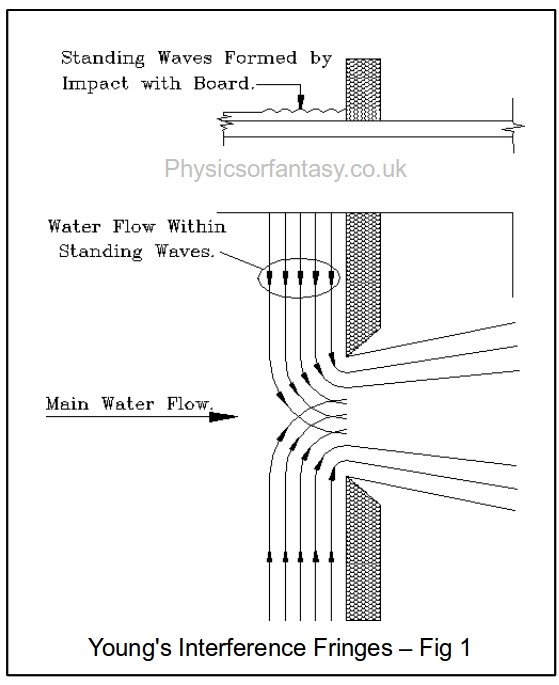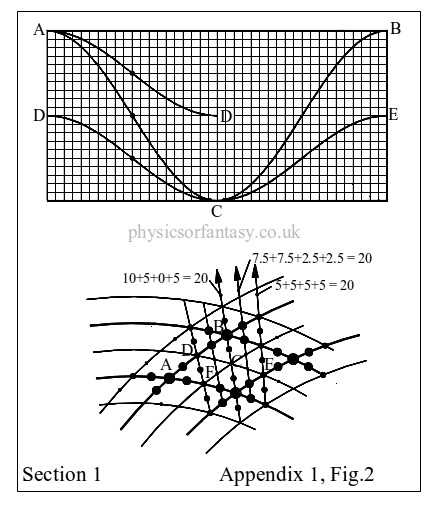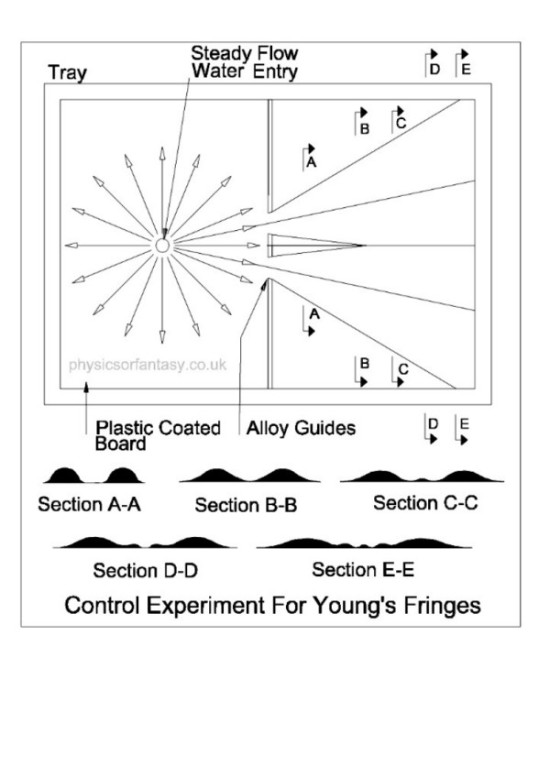-
The Myth of Young’s Interference Fringes.
Posted on March 23rd, 2016 No commentsWhy do physicists never do control experiments?
This basic requirement of experimental work is apparently not considered in physics.

Thomas Young, (1773-1829) carried out various experiments that have ever since been claimed to prove that light has a wave form. His experiments in the early 1800s were based on using experiments with water flow and were claimed to be exactly analogous to sound waves and therefore light. However, we need to fully explore the actual results of these experiments before coming to any rash conclusions.
The above drawing shows water steadily flowing into a barrier that has a slit or gap in it. As the water strikes the barrier a series of standing waves form in front of it. (Yes I know that you have never heard of this before, but they are there but are completely ignored by the physicists, universities and physics teachers). It is easy to check this by using a piece of plastic with a notch cut out of it, and gently running water against it.
These standing waves are created by the mechanics of the experiment and have nothing to do with any inherent wavelike nature of water.
Standing waves do not just stand there without help, they need energy to support them. This energy is supplied by the flow of water within the standing wave. This is a very complex fluid dynamics mechanism. (See. Understanding Waves).
These standing wave forms pass through the slit while still retaining their wave form. Depending on the width of the slit, a cross section of the flow through the slit will show a a series of peaks and troughs THAT WOULD BE ANALOGOUS TO YOUNG’S FRINGES, without indicating that light (or water) had any inherent wavelike nature.
In the drawing below, the lower sketch shows two sets of waves from linked pulsators as used in the Ripple Tank experiments, the origin of Young’s Interference experiments.

The letters A and B relates to where two wave peaks coincide. The letters D and E relate to where a peak from one wave coincides with the trough from another wave. The arrowed lines identify a path through the waves, and the numbers relate the energy at the points shown along the line for one wave cycle. The figures show that the energy balances out and therefore does not show any fringes.
The problem with these experiments is that they were carried out in the belief that the wave theory was correct.
No attempt was made to carry out any control experiments to check if a non-waveform (steady) flow would exhibit fringe-like results. In the ripple tank itself no ‘clear’ fringes are visible.
Note; The assumptions made from these experiments should cause serious concern for human health. The physics establishment have assumed that light operates at frequencies of between 4×1014 Hz (red light) and 8×1014 Hz (violet light). From this they argue that the human body is therefore quite happy to handle ‘electro magnetic’ radiation at these high frequencies. No direct evidence has ever been found indicating that light has waveform or frequency. Since the early 1980s, when I first looked into ‘electro-magnetic’ radiation due to the fact that my computer operated at 1Mhz, I have found no evidence of any form of energy transmission in nature that need electro-magnetics in its operation. The only natural energy transmissions are mechanical (including nerve impulses). The only wavelike energy transmissions in nature are sound and water waves, both mechanical.
The Control Experiment for Young’s Fringes.
Below is the set up for the control experiment that I carried out many years ago.

It should be noted that these standing waves are not directly related to the standing waves in figure 1. In this control experiment the impact waves as created in figure 1 only apply to the separator between the two slits, the water on each side of the slits will tend to run away from the slits due to the angle of water flow. The standing waves from the separator will be much smaller, but may actually help in initially starting the standing waves in this control experiment.
The number of interface standing waves (or fringes) depends on the separation of the slits, the speed of the water and distance from slits. As the distance from the slits increases, so the number of ‘fringes’ increases.
There are numerous examples of this creation of standing waves in fluid dynamics.
More to come on this later.
Author- Brian Williams

